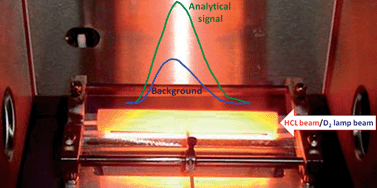This study reports the use of background signals and multivariate calibration as a procedure to assess total concentration of concomitants in thermospray flame furnace atomic absorption spectrometry (TS-FF-AAS). TS-FF-AAS employs a metal tube atomizer above an air/acetylene flame and the atoms residence time is longer than that observed in FAAS (flame AAS). As a result, elevated background signals are obtained. The main purpose of this study is to make use of the background signals to predict the total concentration of concomitants. Background signals of 29 solutions containing Cd (25 µg L−1), Pb (500 µg L−1) and four concomitants (Ca, K, Mg and Na—total concentration values ranging from 0 to 5.52 g L−1) were recorded at two wavelengths: 228.8 nm for Cd and 283.3 nm for Pb. With the help of partial least squares, calibration models using either each wavelength alone or a combination of both were constructed to predict the total concentrations of concomitants. The best model showed root mean square error of validation (RMSEV) of 0.35 g L−1 using background signals at 283.3 nm. A pharmaceutical sample containing 3 g L−1 of the total concentration of Ca, K, Mg and Na was analyzed and 3% was the relative error. This sample and those used in the calibration/validation sets were also analyzed using X-ray fluorescence (XRF) and a good agreement was observed. This study extends the possibilities for the use of background signals in spectrometric techniques.

You have access to this article
 Please wait while we load your content...
Something went wrong. Try again?
Please wait while we load your content...
Something went wrong. Try again?


 Please wait while we load your content...
Please wait while we load your content...